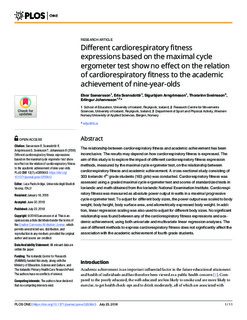| dc.contributor.author | Saevarsson, Elvar | |
| dc.contributor.author | Svansdottir, Erla | |
| dc.contributor.author | Arngrimsson, Sigurbjorn | |
| dc.contributor.author | Sveinsson, Thorarinn | |
| dc.contributor.author | Johannsson, Erlingur | |
| dc.coverage.spatial | Iceland | nb_NO |
| dc.date.accessioned | 2019-02-08T09:52:03Z | |
| dc.date.available | 2019-02-08T09:52:03Z | |
| dc.date.created | 2018-09-12T14:44:56Z | |
| dc.date.issued | 2018 | |
| dc.identifier.citation | Saevarsson, E., Svansdottir, E., Arngrimsson, S., Sveinsson, T., & Johannsson, E. (2018). Different cardiorespiratory fitness expressions based on the maximal cycle ergometer test show no effect on the relation of cardiorespiratory fitness to the academic achievement of nine-year-olds. Plos One, 13(7), 1-11. | nb_NO |
| dc.identifier.issn | 1932-6203 | |
| dc.identifier.uri | http://hdl.handle.net/11250/2584542 | |
| dc.description.abstract | The relationship between cardiorespiratory fitness and academic achievement has been inconclusive. The results may depend on how cardiorespiratory fitness is expressed. The aim of this study is to explore the impact of different cardiorespiratory fitness expression methods, measured by the maximal cycle ergometer test, on the relationship between cardiorespiratory fitness and academic achievement. A cross-sectional study consisting of 303 Icelandic 4th grade students (163 girls) was conducted. Cardiorespiratory fitness was assessed using a graded maximal cycle ergometer test and scores of standardized tests in Icelandic and math obtained from the Icelandic National Examination Institute. Cardiorespiratory fitness was measured as absolute power output in watts in a maximal progressive cycle ergometer test. To adjust for different body sizes, the power output was scaled to body weight, body height, body surface area, and allometrically expressed body weight. In addition, linear regression scaling was also used to adjust for different body sizes. No significant relationship was found between any of the cardiorespiratory fitness expressions and academic achievement, using both univariate and multivariate linear regression analyses. The use of different methods to express cardiorespiratory fitness does not significantly affect the association with the academic achievement of fourth grade students. | nb_NO |
| dc.language.iso | eng | nb_NO |
| dc.publisher | PLOS | nb_NO |
| dc.rights | Navngivelse 4.0 Internasjonal | * |
| dc.rights.uri | http://creativecommons.org/licenses/by/4.0/deed.no | * |
| dc.title | Different cardiorespiratory fitness expressions based on the maximal cycle ergometer test show no effect on the relation of cardiorespiratory fitness to the academic achievement of nine-year-olds | nb_NO |
| dc.type | Journal article | nb_NO |
| dc.type | Peer reviewed | nb_NO |
| dc.description.version | publishedVersion | nb_NO |
| dc.rights.holder | © 2018 Saevarsson et al. | nb_NO |
| dc.subject.nsi | VDP::Medisinske Fag: 700::Idrettsmedisinske fag: 850::Treningslære: 851 | nb_NO |
| dc.subject.nsi | VDP::Samfunnsvitenskap: 200::Pedagogiske fag: 280::Andre pedagogiske fag: 289 | nb_NO |
| dc.source.volume | 13 | nb_NO |
| dc.source.journal | PLoS ONE | nb_NO |
| dc.source.issue | 7 | nb_NO |
| dc.identifier.doi | 10.1371/journal.pone.0200643 | |
| dc.identifier.cristin | 1608933 | |
| cristin.unitcode | 203,1,32,0 | |
| cristin.unitname | Senter for utdanningsforskning - Bergen | |
| cristin.ispublished | true | |
| cristin.fulltext | original | |
| cristin.qualitycode | 1 | |

